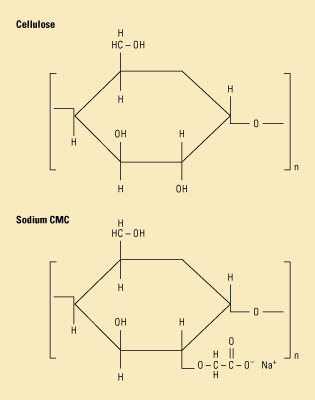1. n. [Drilling Fluids]
A low viscosity grade of drilling-fluid additive used primarily for fluid-loss control, manufactured by reacting natural cellulose with monochloroacetic acid and sodium hydroxide [NaOH] to form CMC sodium salt. Up to 20 wt % of CMC may be NaCl, a by-product of manufacture, but purified grades of CMC contain only small amounts of NaCl. To make CMC, OH groups on the glucose rings of cellulose are ether-linked to carboxymethyl (-OCH2-COO-) groups. (Note the negative charge.) Each glucose ring has three OH groups capable of reaction, degree-of-substitution = 3. Degree of substitution determines water solubility and negativity of the polymer, which influences a CMC's effectiveness as a mud additive. Drilling grade CMCs used in muds typically have degree-of-substitution around 0.80 to 0.96. Carboxymethylcellulose is commonly supplied either as low-viscosity (""CMC-Lo Vis"") or high-viscosity (""CMC-Hi Vis"") grades, both of which have API specifications. The viscosity depends largely on the molecular weight of the starting cellulose material.
Reference: Hughes TL, Jones TG and Houwen OW: "The Chemical Characterization of CMC and Its Relationship to Drilling-Mud Rheology and Fluid Loss," SPE Drilling & Completion 8, no. 3 (September 1993): 157-164.
Synonyms: CMC-Lo Vis
See related terms: carboxymethyl starch, carboxymethyl hydroxyethylcellulose, carboxymethylcellulose, cellulosic polymer, CMC, emulsion mud, hydroxyethylcellulose, polyanionic cellulose
